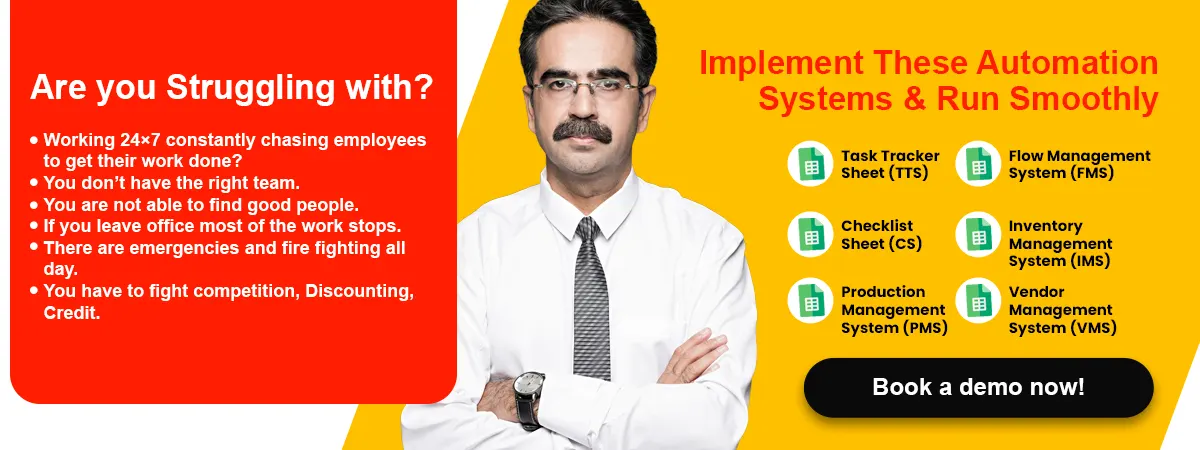by Subhadeep Chowdhury
Share

In today’s fast-paced business world, staying competitive requires more than just a great product or service – it demands efficiency and agility. This is where Business Process Automation (BPA) comes into play. BPA is the key to streamlining operations, reducing errors, and enhancing productivity.
If you want to boost your organization’s performance and save valuable time and resources, then you have come to the right place. In this blog post, we will provide you with invaluable tips for Business Process Automation that will transform the way you do business. From identifying automation opportunities to selecting the right tools, we have got you covered.
Expert Tips for Business Process Automation
So, let’s dive in and harness the power of automation to propel your business to new heights!
-
Identify Your Automation Opportunities:
The first step towards successful Business Process Automation is identifying the areas in your organization that can benefit the most from automation. Start by conducting a thorough analysis of your current processes. Look for tasks that are repetitive, time-consuming, and prone to human errors. These are prime candidates for automation. Pay close attention to workflows that involve data entry, document handling, and communication between systems.
Consider involving employees at all levels in this assessment. They often have valuable insights into inefficiencies and bottlenecks that can be automated. Additionally, gathering input from various departments will ensure that you don’t overlook any opportunities for improvement.
Once you have identified these areas, prioritize them based on their potential impact on your organization. Start with processes that can provide quick wins or have a significant ROI. This strategic approach will help you maximize the benefits of Business Process Automation while minimizing implementation costs.
-
Set Clear Objectives:
Before diving headfirst into Business Process Automation, it is quite crucial to establish clear objectives. Determine what you want to achieve through automation and define your key performance indicators (KPIs) to measure success.
Are you aiming to reduce operational costs, improve customer satisfaction, or increase productivity? Setting specific goals will guide your automation efforts and ensure that you are on the right track.
Remember that Business Process Automation is not a one-size-fits-all solution. Your objectives should align with your organization’s overall strategy and long-term goals. This will help you make informed decisions when selecting automation tools and designing workflows.
-
Choose the Right Automation Tools:
Selecting the right automation tools is critical to the success of your BPA efforts. There are various software solutions available, each tailored to different aspects of automation, such as workflow automation, document management, and data integration. To make an informed choice, consider the following factors:
- Compatibility: It is crucial to ensure that the automation tools you select are fully compatible with your existing systems and software. Seamless integration is essential to prevent disruptions in your daily operations. A lack of compatibility can lead to data inconsistencies, workflow bottlenecks, and increased complexity. Choosing tools that seamlessly integrate with your current technology stack will facilitate a smoother transition to automation.
- Scalability: When evaluating automation tools, consider their scalability. Your business is likely to grow and evolve over time, and your automation needs will change accordingly. Select tools that can easily adapt and grow with your organization. This way, you won’t find yourself in a situation where you’ve outgrown your chosen solution, leading to additional costs and disruptions in your automation processes.
- User-Friendly Interface: Opt for automation tools that offer an intuitive and user-friendly interface. A user-friendly design is essential for successful adoption among your team members. Complicated or confusing interfaces can lead to resistance and slow down the implementation process. Prioritizing user-friendliness ensures that your team can quickly and effectively leverage the automation tools, maximizing their benefits and reducing the learning curve.
- Support and Training: When assessing potential automation tools, inquire about the support and training resources provided by the vendor. Adequate support and training are essential for a smooth transition to automation. Your team should have access to assistance whenever they encounter challenges or require guidance. This includes technical support, documentation, online tutorials, and training programs. A responsive vendor with robust support and training resources will help ensure the success of your automation project by addressing issues promptly and helping your team become proficient users.
Also, read our article on: Embracing Automation In Business Management Systems
-
Map Out Your Workflows:
Once you’ve identified the processes to automate and selected the right tools, it’s time to map out your workflows. This involves creating a visual representation of how tasks and information flow within your organization. Workflow mapping helps you identify bottlenecks, redundancies, and areas where automation can be applied effectively.
During this phase, collaborate with employees who are directly involved in the processes. Their insights can be invaluable for designing efficient workflows that meet their needs. Consider using workflow automation software to create, test, and optimize your workflows before implementation.
-
Start Small and Iterate:
When implementing Business Process Automation, it’s wise to start small and gradually expand your automation efforts. Choose a pilot project that is manageable in scope and complexity. This allows you to test the waters, identify any potential challenges, and fine-tune your processes before rolling out automation across the entire organization.
Starting small also helps build confidence among your team members. As they witness the positive impact of automation on a smaller scale, they will be more receptive to broader automation initiatives.
-
Train Your Team:
Effective training is essential for the successful adoption of automation within your organization. Ensure that your team is well-versed in using the selected automation tools and understands the new workflows. Provide comprehensive training programs and resources to help employees get up to speed.
Additionally, create a culture of continuous learning and improvement. Encourage your team to explore new automation possibilities and share their ideas for process enhancement. When employees feel empowered and knowledgeable, they are more likely to embrace automation as a valuable asset.
-
Monitor and Measure Performance:
Regular monitoring and measurement are vital to gauge the effectiveness of your Business Process Automation efforts. Track key performance indicators (KPIs) related to your automation objectives. These could include metrics like process cycle times, error rates, cost savings, and customer satisfaction scores.
Use the data collected to identify areas where further optimization is needed. Automation is not a one-time solution; it requires ongoing evaluation and refinement to ensure that it continues to deliver value to your organization.
Also read Effective Solutions For Business Management Problems
-
Stay Updated with Technology:
The field of automation is constantly evolving, with new technologies and tools emerging regularly. To stay competitive and maximize the benefits of automation, it’s essential to stay updated with the latest advancements. Keep an eye on industry trends and consider how emerging technologies like artificial intelligence (AI) and machine learning can enhance your automation efforts.
Regularly review your automation strategies and adapt them as needed to leverage new opportunities and address changing business needs. Being proactive in embracing technological advancements will give you a competitive edge in the market.
-
Seek Consultancy From Professionals
In our pursuit of streamlining business processes through automation, our last Tips underscore the significance of seeking expert guidance, and we wholeheartedly advocate considering ECONSTRA. At our firm, we recognize ECONSTRA as a premier business consultancy specializing in delivering tailor-made systems for business automation. We find their expertise invaluable, as their seasoned professionals possess a wealth of experience in guiding businesses through the intricacies of automation adoption. With ECONSTRA, we experience more than just a service provider – we have a collaborative partner committed to understanding our specific business needs. Together, we craft strategies that seamlessly integrate automation into our operations, ensuring a customized and efficient solution. Partnering with ECONSTRA empowers us to not only navigate the challenges of automation but also to embrace the transformative potential it brings to our business.
Conclusion: Tips for Business Process Automation
In conclusion, Business Process Automation is a game-changer for organizations looking to streamline their operations, increase efficiency, and stay ahead of the competition. By following these ten essential tips for Business Process Automation, you can embark on a journey to transform your business into a lean, agile, and highly productive entity.
Remember to start by identifying automation opportunities, setting clear objectives, and choosing the right tools. Map out your workflows, start small, and prioritize training for your team. Continuously monitor and measure performance, and stay updated with the latest technology trends to ensure that your automation efforts remain effective and future-proof.
With the right approach and commitment to automation, you can unlock new levels of efficiency and productivity, enabling your organization to thrive in today’s ever-evolving business landscape.
So, don’t wait – start automating your processes and reap the rewards of Business Process Automation today!
STAY IN THE LOOP
Subscribe to our free newsletter.
Business consultant services provide the strategic insight and expertise necessary to steer your company through various challenges and opportunities. These professionals play a crucial role in helping businesses identify growth opportunities, optimize operations, and achieve long-term success. Understanding the Role of a Business Consultant A business consultant acts as an external advisor who brings a […]
In today’s competitive business landscape, companies are constantly seeking ways to reduce operational costs while maintaining or improving efficiency and customer satisfaction. Customer Relationship Management (CRM) systems have emerged as vital tools that enable businesses to achieve these goals. As a leading business consultancy, Econstra understands the importance of leveraging CRM technology to streamline operations, […]
Why Operational Costs Are Draining Your Profits? Operational costs are a critical aspect of running a successful business, but when not managed properly, they can drain your profits and stifle growth. In a competitive market, maintaining profitability requires keen oversight of expenses and strategic planning. Econstra, as a leading business consultancy, provides insights and strategies […]
In the rapidly advancing digital landscape, Artificial Intelligence (AI) tools have emerged as transformative assets for businesses. Their potential to enhance efficiency, streamline operations, and drive innovation makes them invaluable for business consultants and organizations worldwide. For business consultants in India, AI’s strategic application can be particularly advantageous in navigating a diverse and dynamic market. […]





